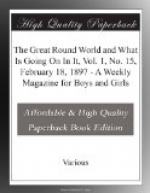At the death of the Emperor Augustus, the population of the earth was estimated at 54,000,000.
DEAR MR. EDITOR:
My father receives your little paper, THE GREAT ROUND WORLD, every week. I like it real well, and all the rest of the people and children I have let take one of the copies liked it so well I let them take more copies. I think it a very nice little paper, and wish you success. I send you the following extract, taken from “Wit and Wisdom,” showing that the X-rays are not a recent discovery altogether.
THOMAS
C. SCOTT.
BINGHAMTON, N.Y., Jan. 25th.,
1897.
“Dr. Milio, the celebrated surgeon of Kieff, while on a visit to St. Petersburg, explained the means he had invented for illuminating the body by means of the electric light to such an extent that the human machine may be observed almost as if skin and flesh were transparent. The Moscow Gazette asserts that to demonstrate the feasibility of his process, Dr. Milio placed a bullet inside his mouth, and then lighted up his face, upon which the bullet became distinctly visible through his cheek. Dr. Milio did not propose to lay bare all the secrets of the flesh, to explore the recesses of the heart, or to perform any miracles, physical or metaphysical. But he claimed to have discovered a new and effective way of dealing with gun-shot wounds: first, by means of electric illumination, he discovered the precise situation of the bullet; next, by means of magnetism, he proposed to extract the bullet, provided always that the bullet contained some portion of steel. Against leaden bullets his system is powerless, and he therefore intended to represent to the International Committee, which met at Geneva, the desirability of recommending an admixture of steel in the manufacture of all future bullets. Dr. Milio’s experiments with bullets containing only a slight admixture of steel are said to have been thoroughly successful.”
DEAR THOMAS:
Your letter is very interesting.
It has long been known that it is possible to see through matter if we only knew just how. The X-ray has shown us the way.
THE EDITOR.
TO THE EDITOR OF THE GREAT ROUND WORLD:
In your edition of Jan. 21st, 1897, you wrote of the swallowing up by the sea of Robinson Crusoe’s Island, or the island of Juan Fernandez. Now I have always heard this island called “Robinson Crusoe’s Island,” and I think the reason is, that Alexander Selkirk was cast away there, and on his adventures the story of Robinson Crusoe was written by Daniel Defoe. But I have read “Robinson Crusoe,” and the island as described by him cannot be the Island of Juan Fernandez, but must be one of the Windward Islands in the Caribbean Sea, off the mouth of the great Orinoco River in South America, and I think is the Island of Tobago; this best fits the careful description of Daniel Defoe.
In Crusoe’s first exploration of the island he says:




